How To Make A Cake Glaze
Chocolate Mirror Glaze – or Glacage Chocolat in French – is the most stunning of all cake glazes! Made with a uncomplicated mixture of cocoa, foam, sugar, water and gelatine, it'southward used to make Mirror Cakes similar this elegant Chocolate Glazed Mirror Cake with layers of chocolate block and chocolate ganache.
No special equipment required – just a meat thermometer and strainer. (Yes, I said meat thermometer!)
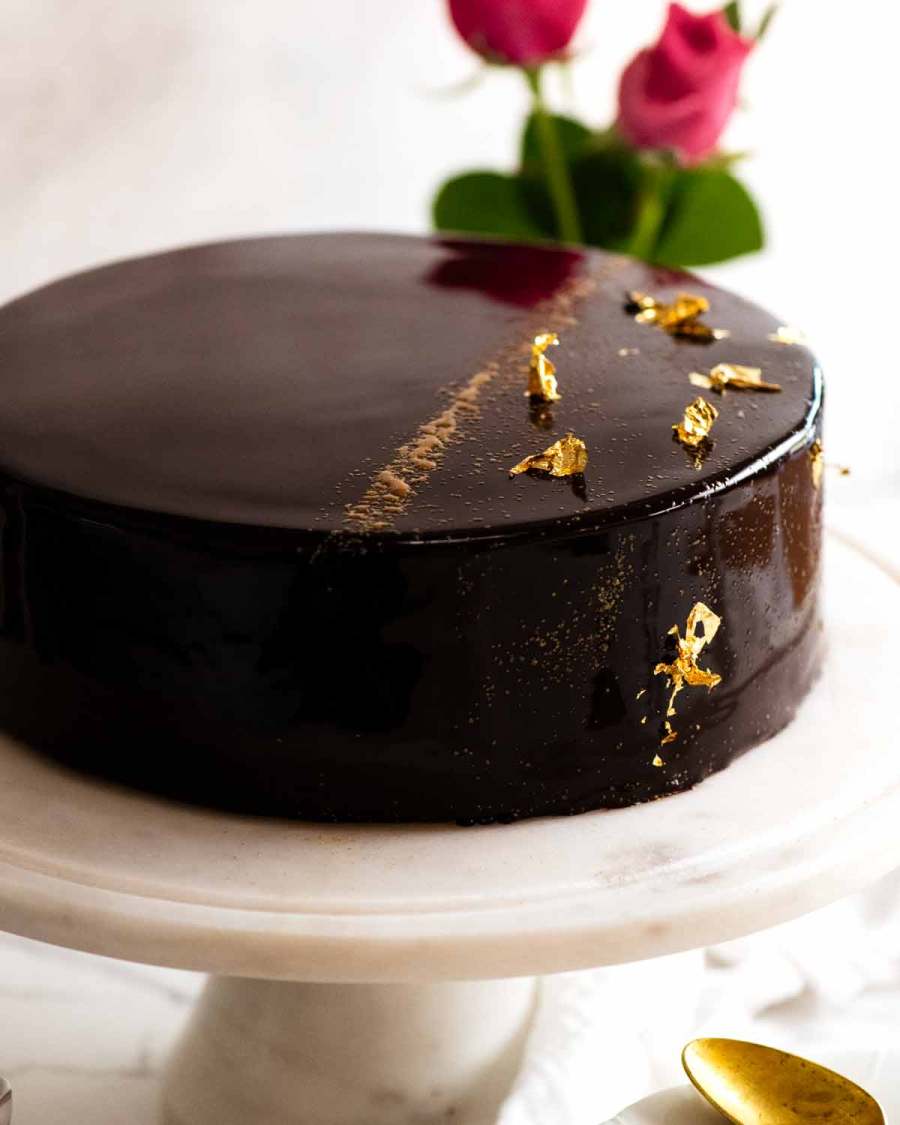
Chocolate Mirror Glaze
If you've ever wanted to but been too intimidated by the thought of producing beautiful French patisserie-fashion cakes, Chocolate Mirror Coat is an first-class place to start because:
-
It'south much easier than you think. It calls for patience above all else (you will read the words "cool" and "fridge" a lot!);
-
Yous can use mirror glaze on nearly any block; and
-
Yous don't demand whatever specialty ingredients or patisserie equipment – merely a meat thermometer and strainer!
It'due south a keen show-off cake, ane that anybody oohs and ahhs over how shiny and reflective the coat is – merely like a mirror!
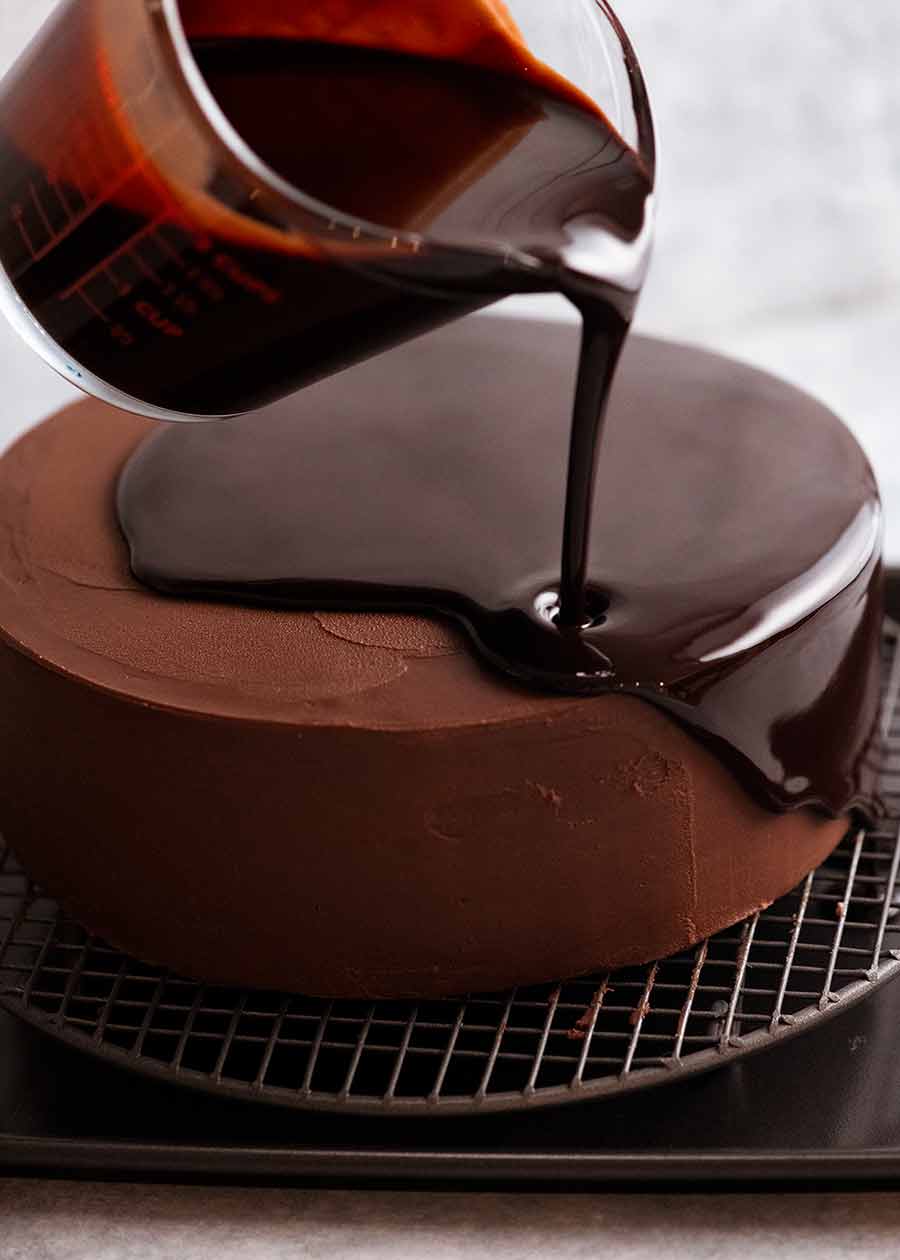
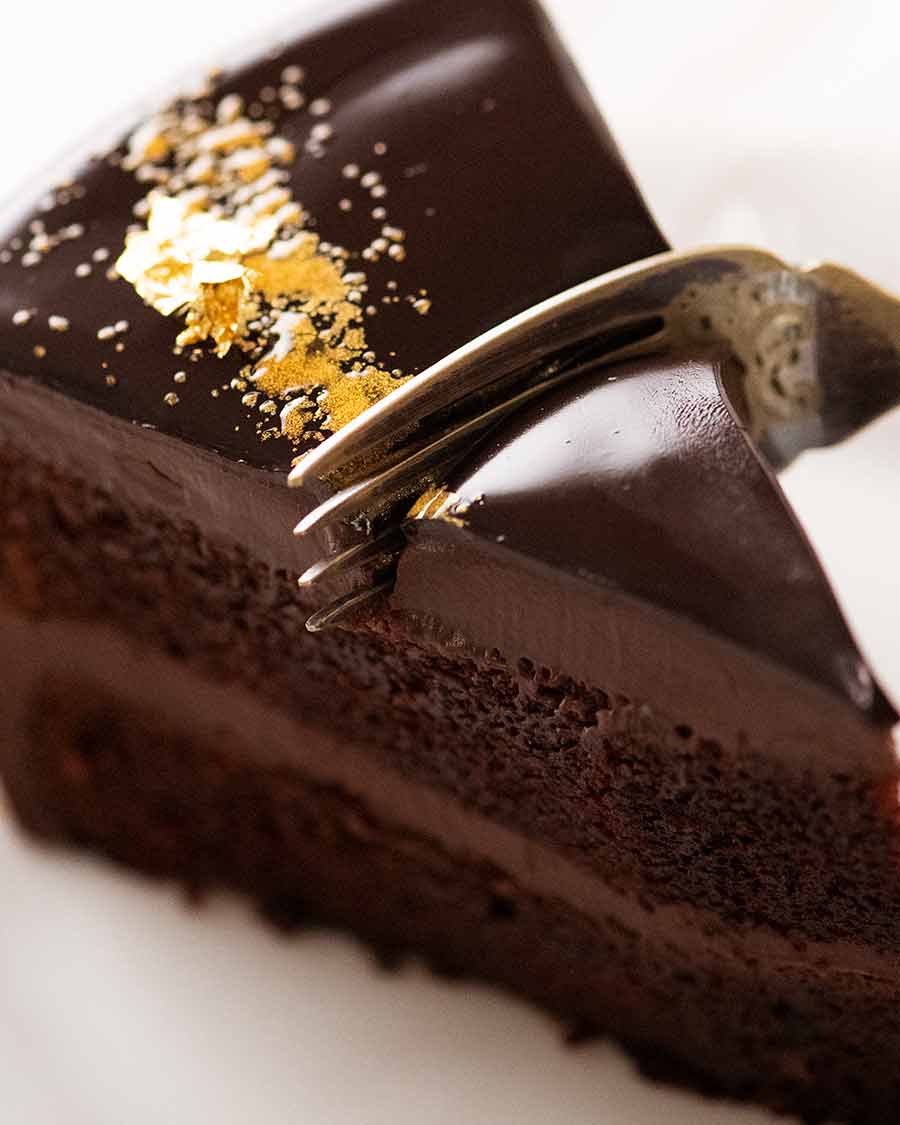
What makes Mirror Glazes shiny?
The ingredient that makes Mirror Glazes so shiny is gelatine. Information technology makes the glaze gear up into a glossy, thin layer of what is essentially chocolate jelly. That might sound slightly unappealing merely when executed properly, it functions as a very, very thin layer of soft jelly encasing a frosting or mousse of some sort underneath.
Since gelatine liquifies when heated and the glaze is so thin, the warmth of your oral cavity causes the glaze to instantly melt in your rima oris when you eat it. So you don't perceive a "jelly" texture and barely find it is in that location!
In fact, I consider Mirror Glazes to exist all for show and nothing more, and this is really the concept behind it. Information technology will make a cake wait impressive, only like most things in life, it's what's underneath that actually matters!
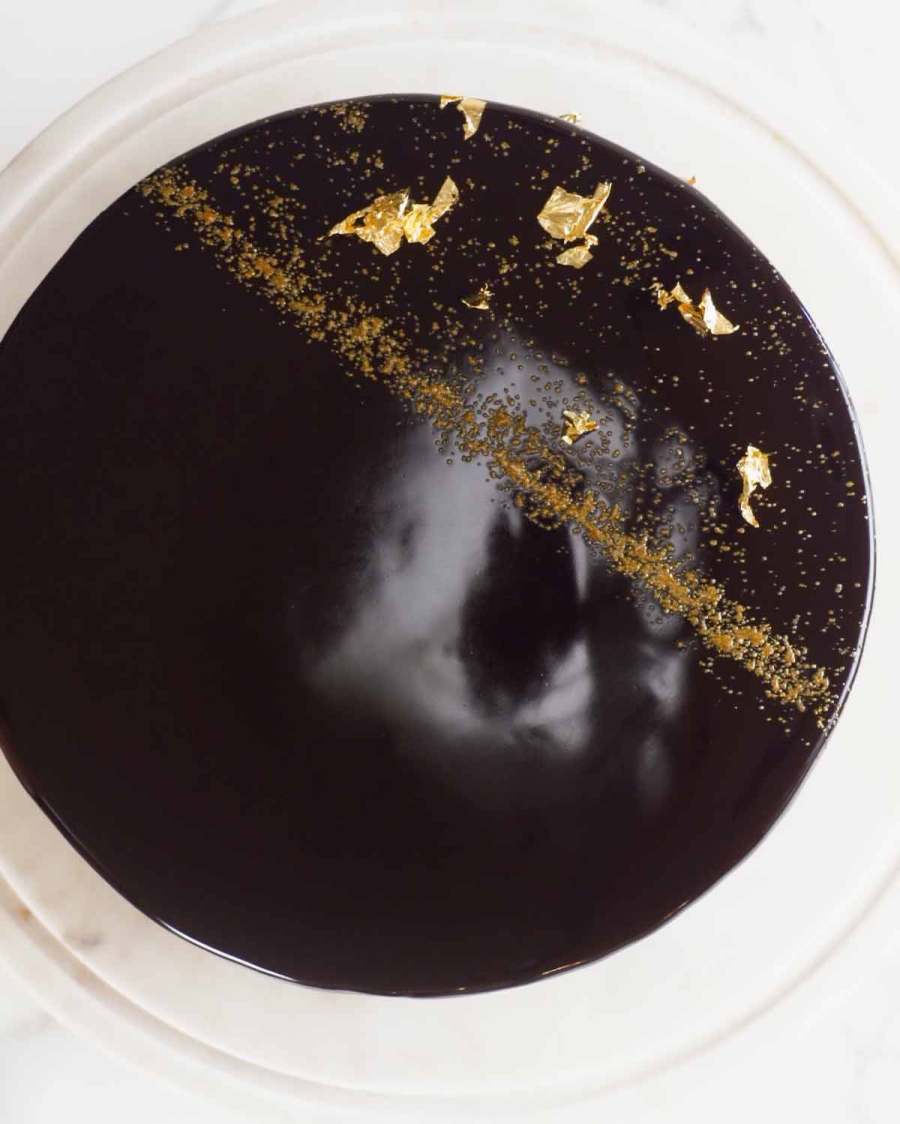
What is Mirror Glaze made of?
A archetype Chocolate Mirror Glaze is fabricated of gelatine, water, foam, saccharide and cocoa powder.
Some recipes utilise melted chocolate and condensed milk, but they aren't as nice to eat. They make a yield a thicker, less elegant Mirror Glaze that's also overly sweet. More on alternative Mirror Glazes beneath.
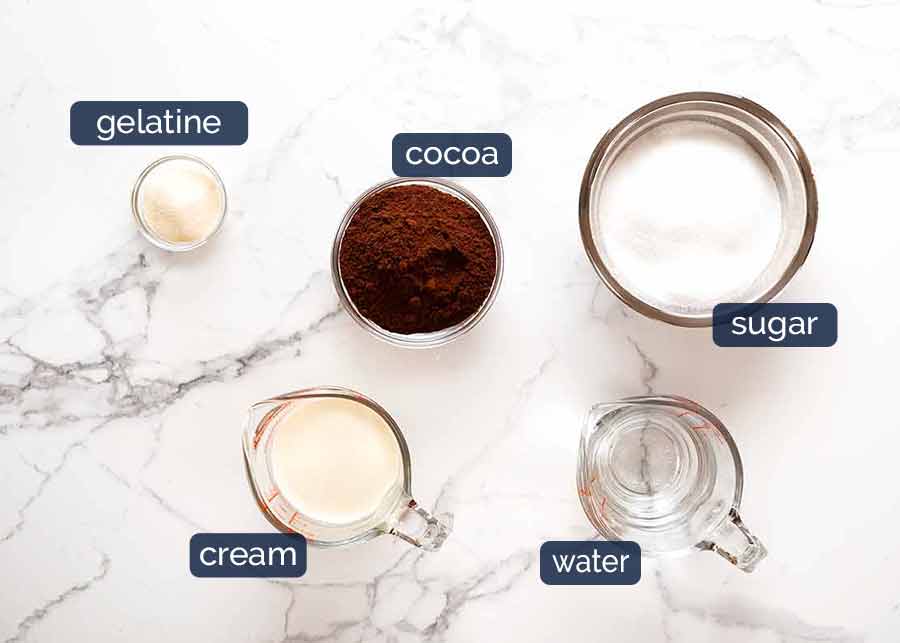
-
Gelatine – while professional patisseries volition utilize leaf gelatine, I opt for powdered gelatine considering it's more than standardised globally, affordable and still yields perfect results. Leafage gelatine comes in different grades and strengths, and also economical ones are not always reliable (as I found out during the creation of this Mango Cheesecake!). Powder is easier and safer;
-
Foam – pure foam is best, but thickened and heavy foam work equally well. Full-fat power needed hither – this is non the time to muck around with low fat alternatives!!!
-
Cocoa powder – Dutch process(ed) cocoa powder is all-time, for intensity of flavour and a deeper dark colour. Notwithstanding, everyday standard cocoa works 100% perfectly here and is an excellent, more than economical alternative; and
-
Sugar – but ordinary white sugar.
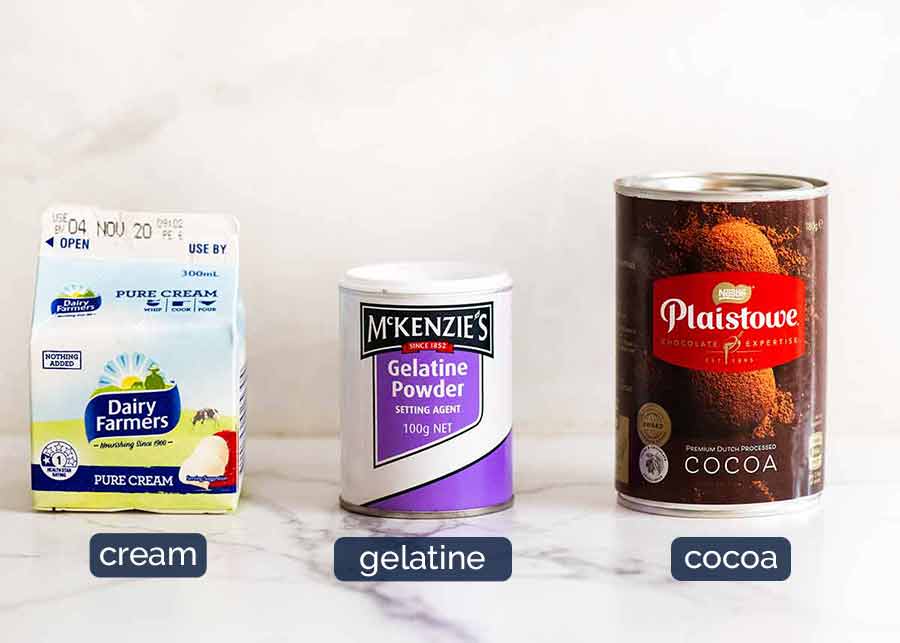
No to condensed milk and melted chocolate in Mirror Glazes!
Some recipes telephone call for melted chocolate and condensed milk instead of cream. This makes a thicker layer of mirror coat which helps disguise more blemishes on the surface of the block. But information technology'due south not as nice to eat because it makes the glaze thicker than platonic (more than like 4 – 5mm), so you perceive a bit of jelly texture.
Likewise information technology starts to lose its shine after well-nigh 36 hours – whereas this Mirror Coat stays shiny for days and days!
The no-condensed milk recipe I nowadays here was taught to me past a professional person pastry chef who has worked in some of the finest restaurants in Sydney. It's a more technically perfect method that creates a thin 2 – three mm layer (as it should be!) that literally dissolves in your mouth.
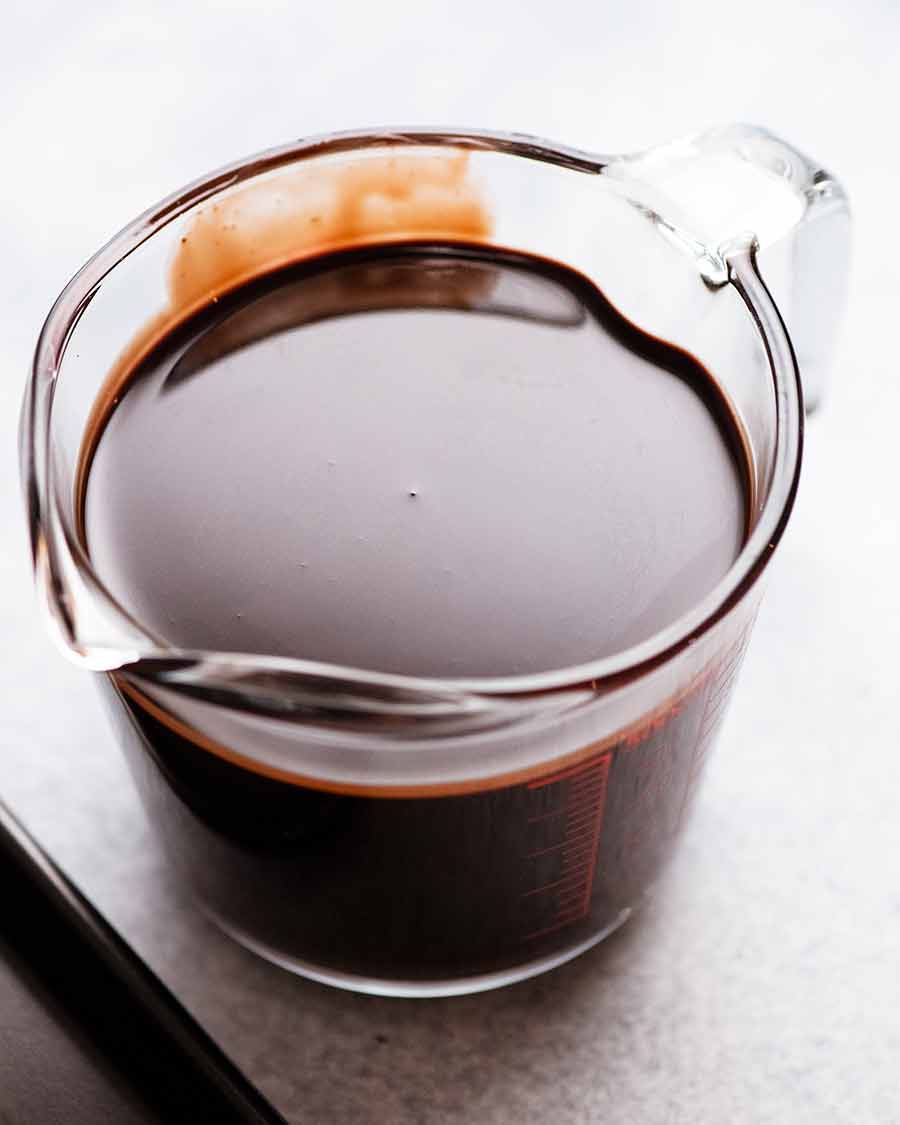
Mirror glaze really isn't hard to do if you lot follow some fundamental tips that volition ensure success, even if you're a first timer. At that place are also some troubleshooting tricks to know which I accept deployed many times!
More than anything, Mirror Glazed Cakes require patience. You volition read the words "cool" and "refrigerate" a lot in the following sections!
How to Mirror Glaze a cake
In a nutshell, hither is how to glaze a Mirror Cake:
-
Frost the cake with ganache or buttercream so information technology is as level and smooth every bit possible – come across dissever tutorial How to Make Frosting and Ganache Smooth on Cakes ;
-
Make the mirror glaze so let it cool then information technology doesn't melt the frosting;
-
Cascade the glaze over the block and be mesmerised past the glistening pall of chocolate that cascades across and down the sides of your block!
-
Transfer the cake without messing up the glaze; and
-
Fix any blemishes using a couple of handy tricks.

Part 1: Frosting the block
A flat, even block surface is essential for beautiful smooth, flawless mirror glazes because the shiny nature of the coat makes bumps and moulds highly visible. See this separate post for my directions: How to Make Frosting Smoothen on Cakes.
Here'south a piffling preview of the technique: Piping the frosting on each layer and on the sides then spreading is the nearly efficient and effective way (some other handy pâtissier technique I recently learned!):
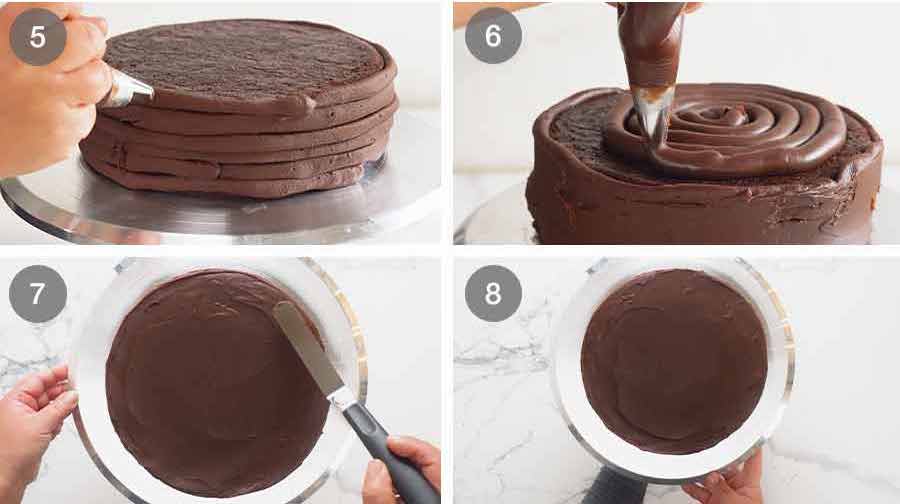
No crumb coating required
Using this snail pipage technique to utilise the frosting or ganache means you don't need to do a crumb coat starting time. Crumb coating is a cake decorating technique where a thin smear of frosting is applied all over the block seal in stray crumbs before coating with a proper thick layer of frosting. It makes it easier to spread the frosting smoothly.
Best cake and frosting for Mirror Glazes
I'm using my Chocolate Cake with a chocolate ganache because information technology'south an elegant, archetype combination with truthful wow-factor when combined with the mirror glaze – both visually when you slice it, and in flavor.
Cakes suitable for Mirror Glazes
Yous tin use well-nigh any cake that has some density and stability. I would non recommend really airy, soft or fragile cakes (like Chiffon Cakes) considering they will be difficult to handle and decumbent to easily denting.
A mousse block or a mousse layer is i that could be used without using frosting considering the surface is already soft and smoothen. Just the mousse would need to be hard chilled overnight.
Frosting base for Mirror Glazes
Frosting is required to brand the surface level and smooth for a flawless mirror stop. If yous pour the Mirror Glaze straight on to a naked cake, it will exist bumpy and grainy looking, and the glaze will also soak into the cake.
Any frosting that can be spread smooth to cover bumps on cakes, firms upward when chilled and is dense enough so chocolate mirror coat won't sink or absorb into it when it is poured over.
Hence a fluffy meringue frosting, say, is no good. Nor is a light and fluffy mascarpone frosting. However, a buttercream frosting or chocolate ganache is perfect.
Here are some suggestions for frostings that will piece of work nether a Mirror Gaze:
-
Chocolate Ganache – archetype and elegant, this is what I used;
-
Chocolate Buttercream or Vanilla Buttercream (this is in the Vanilla Cake recipe) – or whatsoever other Buttercream you want;
-
My secret, less-sweet Fluffy Vanilla Frosting – essentially a less sweet, 100% smooth Vanilla Buttercream that firms upwards like butter when chilled;
-
Swiss Meringue or French Meringue Buttercream.
How much frosting practice you need?
As much equally you would ordinarily use to make full and encompass the sides and surface of a cake. Frosting recipes should provide that information!
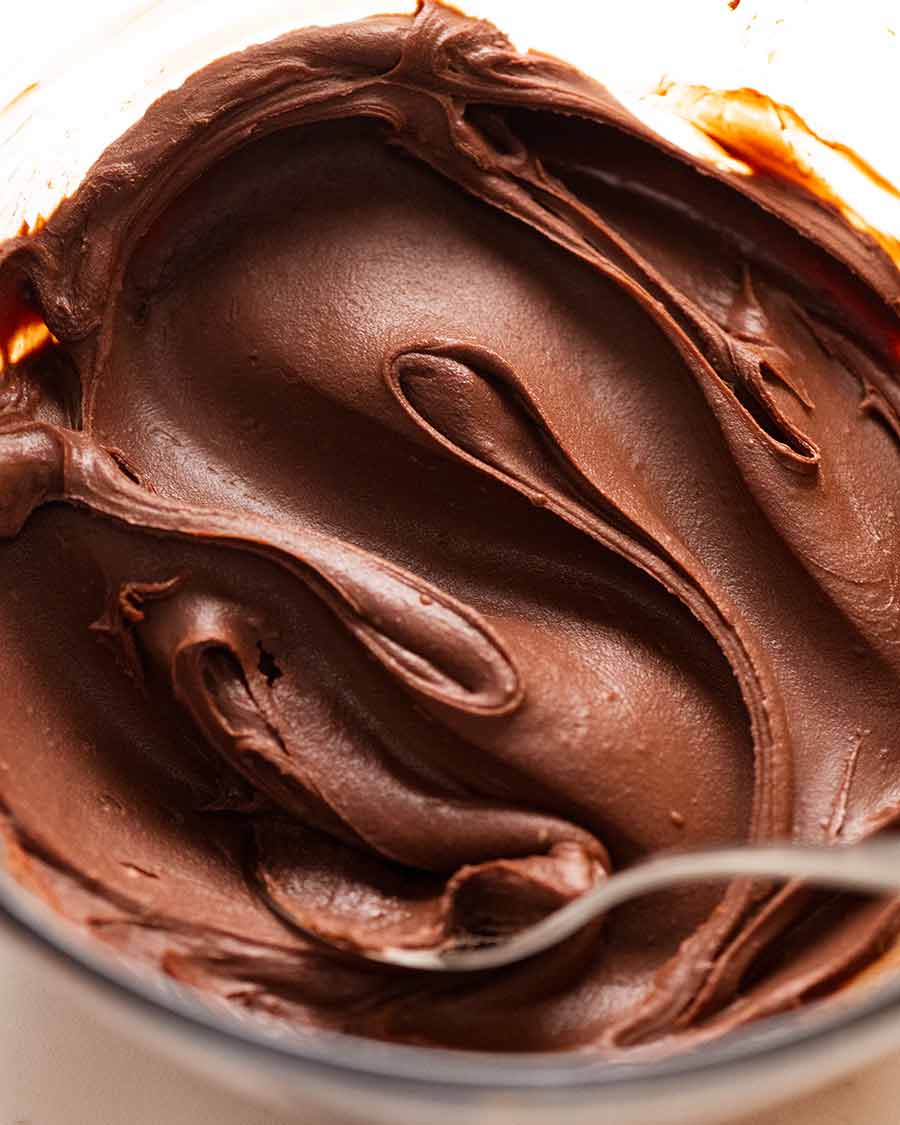
How smooth and level the cake should be for Mirror Glaze Cakes
No affair what yous are pouring the Mirror Glaze over, it needs to be as smooth and level as humanly possible considering the light reflected by the glaze will emphasise imperfections that y'all never normally notice with regular cakes.
Cheque your cake by looking at it from the side. Little smears like you meet on the side of the cake below don't matter – the glaze will hide those as it runs over it. But what does matter are "hills" and dents. The light bouncing off the shiny glaze makes even the smallest mounds await and so much bigger than they are! Mountains out of mole hills indeed …
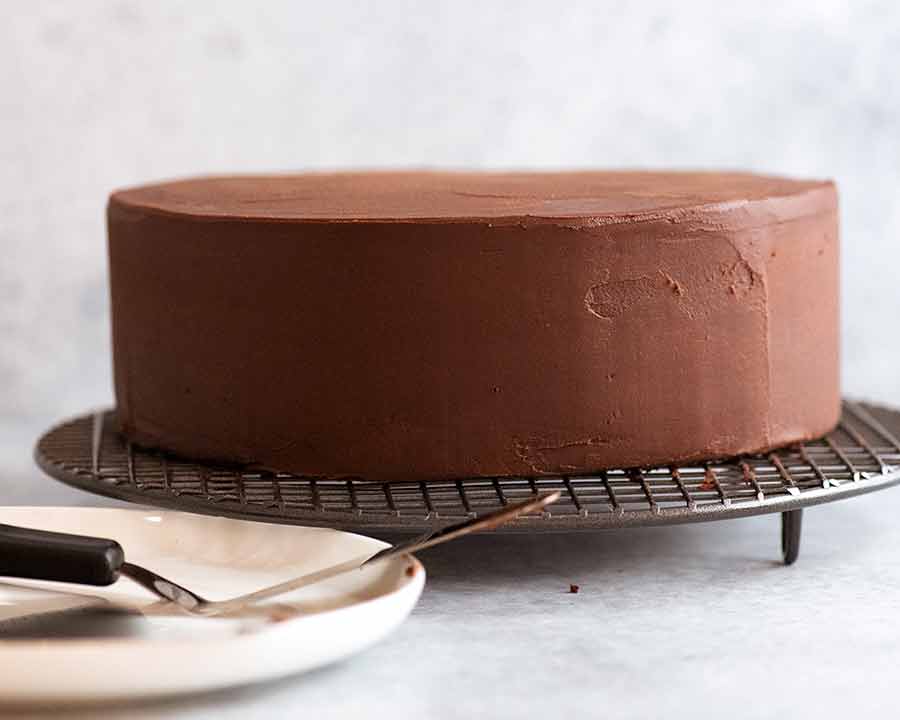
Part 2: Making the Mirror Coat
Making a mirror glaze is very easy IF you lot follow a few key tips that make all the difference between success and lumpy failure:
-
How to avoid gelatine lumps and bubbles in the glaze; and
-
How to accomplish the perfect thickness and temperature and so that when y'all pour it, it'due south not too thin or thick, and doesn't melt the ganache.
I've made all these mistakes, so you don't have to!
Bloom gelatine powder
Gelatine is what makes Mirror Glaze shiny. It's very simple to use and not expensive either.
There's no demand for leaf gelatine. Powdered gelatine works only fine and it'south readily bachelor everywhere.

1. Bloom gelatine – put a modest amount of h2o in a small basin then sprinkle gelatine over.
two. Mix – information technology will fix into a thick paste. Exit for 5 minutes and then the gelatine crystals blot the water. This is chosen blooming gelatine and it allows the gelatine to dissolve smoothly into mixtures. If you simply added the powder straight into the glaze, you'd finish up with lots of lumps.
Making the mirror glaze
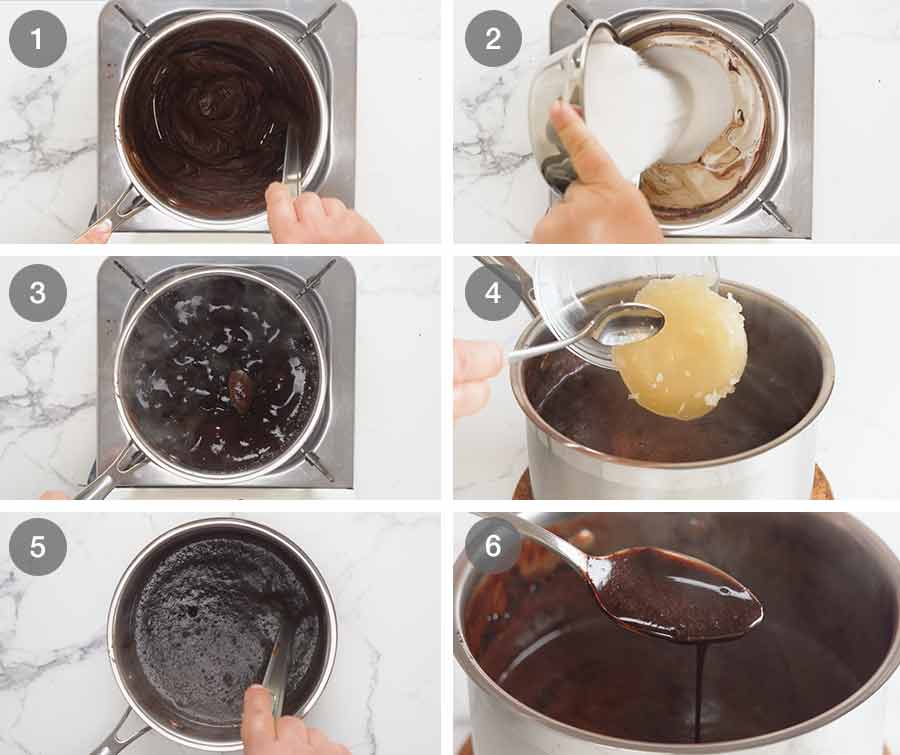
1. Cocoa and water kickoff – In a saucepan, whisk the cocoa powder and h2o to brand a slurry / paste. I found this to exist the easiest way to dissolve cocoa pulverization without whisking/mixing too much (which will create bubbles and ruins the finish of the glaze).
2. Then cream and sugar – Side by side, mix in a chip of cream to loosen the mixture, so add the remaining cream and all the saccharide. Do minimal stirs, enough to just incorporate the cocoa slurry into the cream;
3. Boil – Bring to boil to dissolve the sugar, then take information technology straight off the stove;
4. Dissolve gelatine – Drop the gelatine in (it will take solidified into a rubbery disc);
5. Stir GENTLY – Gently stir to dissolve the gelatine lump. Practice not stir vigorously and practise not utilize a whisk, or you lot'll create bubbles in the glaze which will tarnish the perfect end! It will have a minute or two of stirring simply it will dissolve.
Professional pâtissiers employ a stick blender / immersion blender. Past keeping the head and blades under liquid, it avoids bubbles getting into the mixture. Still, this merely works if you're making large enough batches of coat then the blender head is completely submerged. For a single cake, you'd need to use a shake container or large bricklayer jar, then transfer into a saucepan. Honestly, merely easier to mix cocoa and water first!
half dozen. Glossy! The glaze should be shiny and glossy at this signal, and hopefully bubble gratuitous. If yous have bubbling, don't fret! Nosotros can set up information technology in the adjacent step. If you see a whitish foam on the surface, that's ok also and is easy to deal with; merely exit information technology for now.
Strain and absurd
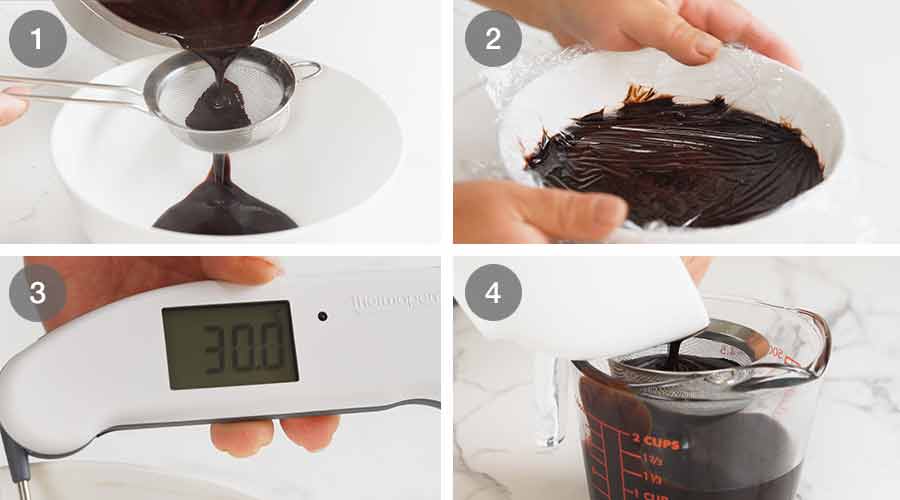
1. Strain – Slowly strain the liquid into a bowl, positioning the strainer such that you minimise the distance the liquid falls from the saucepan into the strainer, and likewise from the base of the strainer into the bowl. This volition reduce the chance of bubbling being created during the straining procedure.
ii. Cover & cool – Embrace the mirror glaze with cling wrap, pressing and so it touches the surface to prevent a skin forming. When y'all peel off the cling wrap in one case the Mirror Glaze is absurd, information technology will skin off any white foam that I mentioned higher up non to worry about.
iii. Cool to 30°C / 86°F – Leave to cool on the counter for ii hours or until it reaches 30°C / 86°F. This is the perfect pouring temperature so information technology blankets the block smoothly without drips, won't melt the ganache and sets in a thin 2 – 3mm layer – the perfect thickness for a mirror glaze.
-
If the glaze is too hot, it will melt the ganache and slide off the block.
-
If the coat is too cold, it won't spread smoothly and you lot'll stop up with drips on the side and lines from the pools of chocolate on the top.
You don't need a fancy processed thermometer. Just use your trusty onetime meat thermometer!
iv. Strain into jug – One time it reaches the target temperature, strain information technology into a jug ready for pouring over the cake. The purpose of this footstep is to remove any residual bubbles, whatever little bits of skin that formed while cooling, and any gelatine lumps that may have formed if it wasn't properly dissolved.
Position the strainer and tilt the jug and then you minimise the distance the liquid falls so you don't create any bubbles. I manage this on my ain, but information technology's easier if you become a helping hand!
Important: Only strain into jug only before using
Do not transfer the mirror glaze into the pouring jug until just before using. Doing this too far in accelerate creates too many unexpected variables which may trigger the need / irresistible desire to stir. That action volition create bubbles. Likewise you will get a pare on the surface which creates unsightly lumps in the glaze.
Part 3: Glazing!
Checklist before yous start pouring to ensure you nail it!
-
Your glaze is at thirty°C/86°F (give or take 2 degrees);
-
You strained into the pouring jug just before using it; and
-
The cake was chilled for least thirty minutes.
You don't demand to possess an proficient's hand with the pouring activeness. You can start and stop pours and it volition still stop upwards shine, though you will go the about flawless stop if y'all tin can practice information technology in one motion.
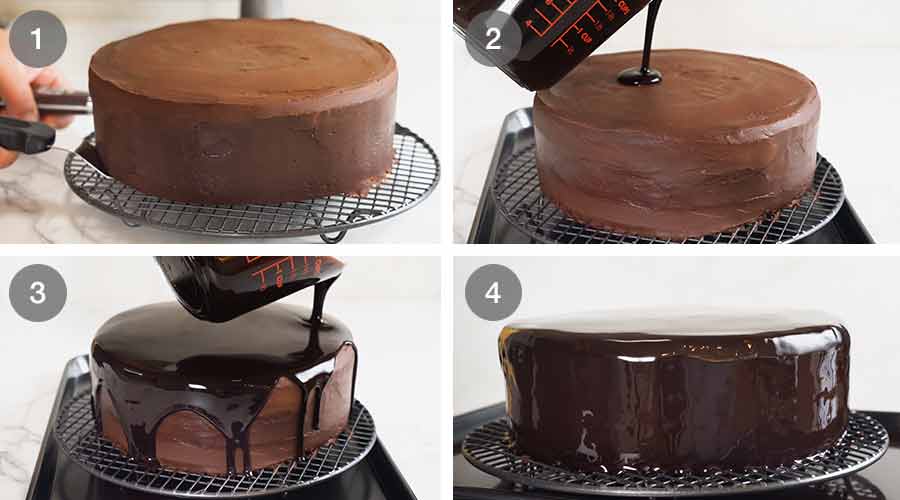
1. Place cake on rack – Transfer the cake to a rack using two 10 kitchen knives or long palette knives (or one of each!). Slide them under the cake, then lift and shift (see below for steps – I utilize this same method after glazing);
ii. Place rack on tray – Gear up the rack with the cake on a tray to catch the excess coat drips;
3. Pour! Starting in the middle of the cake, pour in an expanding spiral move outwards towards the border of the block, so the glaze spreads across the surface and downwardly the sides. Pour with confidence! Don't hesitate or practise a thin stream. Y'all want a steady pouring stream so you lot go a curtain of chocolate coating the sides of the cake rather than piddly footling drips!
Do not touch the glaze once information technology is poured – anything that comes into contact with the coat will leave a mark!
Elevation TIP: Effort to do it in i motion – that is, once you outset pouring, don't stop until all the sides are covered. This is the best mode to ensure you become a perfect, flawless surface. If you demand coat a patch y'all missed on the side, simply pour downwards the edge of the block only, to minimise risk of faint "puddle" lines on the summit of the block. Don't worry, the surface volition still exist apartment.
4. Transfer before it sets! The mirror glaze will get-go to set later on about ten minutes. So transfer the cake to a rack before information technology sets otherwise you'll get little drags on the edge of the base where the you pick information technology up (the glaze sticks to the rack). Encounter next section for how to transfer the cake.
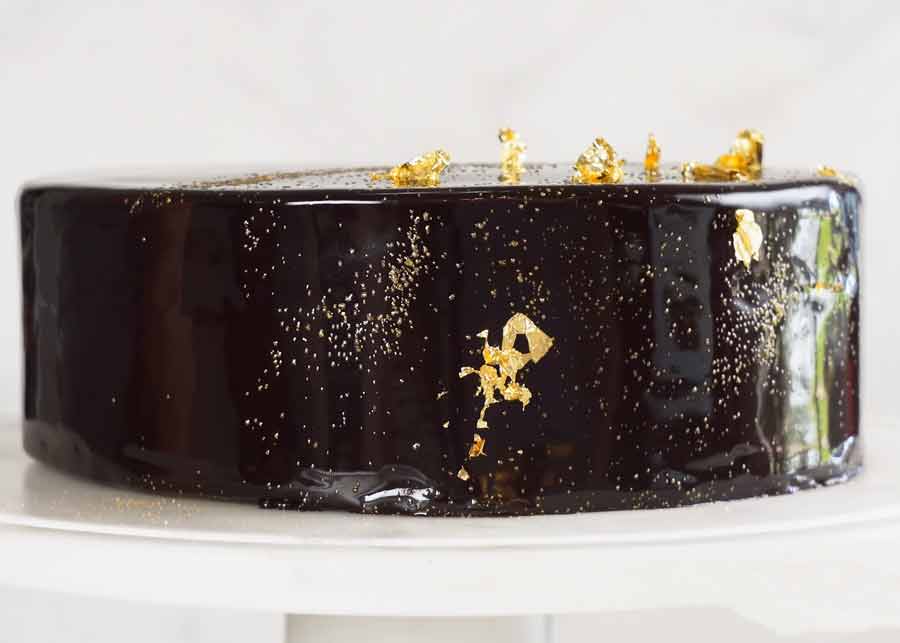
One time a Mirror Glaze is prepare … don't touch!
Mirror Glazes have 5 to 10 minutes to ready. It sets quite quickly because nosotros're pouring it over a fridge common cold ganache or other frosting.
It volition feel similar a soft jelly. It will not crust over similar typical glazes (eg. like the Lemon Glaze in this cake).
To preserve the flawless, shiny glaze, avoid touching the mirror coat once it has been poured. If you lot touch it in one case it has set up, you volition leave a faint fingerprint mark on it.
Part 4: Moving the mirror glazed cake
The most-asked question when I shared a preview of this block was, "How practise you move it!?!?!"
I utilise the same method I used to move the cake on to the rack for glazing once the ganache is on, to shift the finished glazed cake to its serving platter: Using two palette or kitchen knives. Here's how:
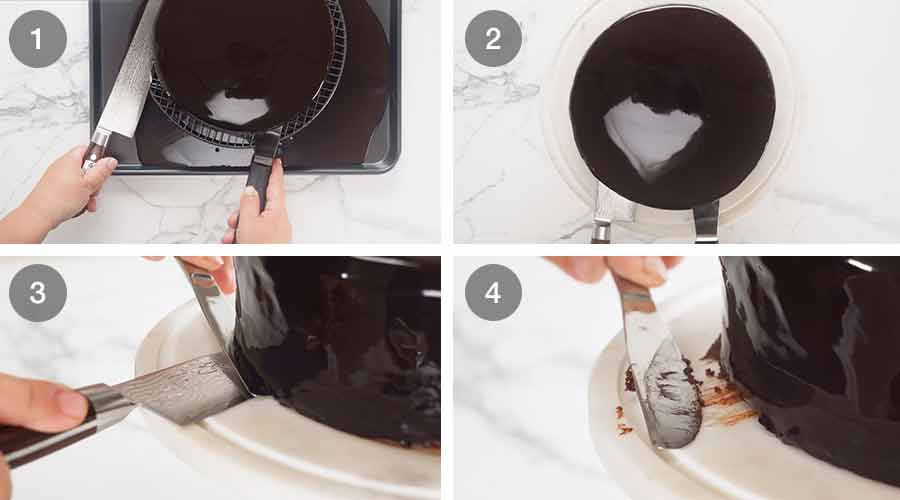
-
Palette knives or kitchen knives – Use either ii long palette knives or two kitchen knives (or ane of each, as I practise!). Slide them under the cake about ane/4 of the manner through – one from the left and ane from the right;
-
Lift them at the aforementioned time so move the cake onto the rack/platter;
-
Push off with a 3rd pocketknife – One time the cake is on the rack/platter, exit the shifting knives in place under the block. Now get a butter pocketknife or modest palette knife to help slide each of the shifting knives out neatly without making the ganache/frosting/mirror glaze untidy; and
-
Voila! Tidy edges! (That's but a smear on the cake platter y'all run across in the higher up footstep photos.)
PRO TIP: Move cake ASAP
Motion the mirror glazed cake straight after pouring the glaze on, before it sets. Otherwise the coat effectually the base of operations of the cake will get-go to fix and stick to the rack. This will cause dragged, untidy bits around the base of the block when you move information technology.
Part 5: Tidying up blemishes
Tidying up blemishes is a useful trick to have upwardly your sleeve with Mirror Glazed Cakes because although we are later all seeking perfection hither, life doesn't always go to program. For example, a poof of wind blowing through the house causing a single dog hair to settle on the otherwise flawless surface of the cake (yep, I'm glaring at Y'all, Dozer!).
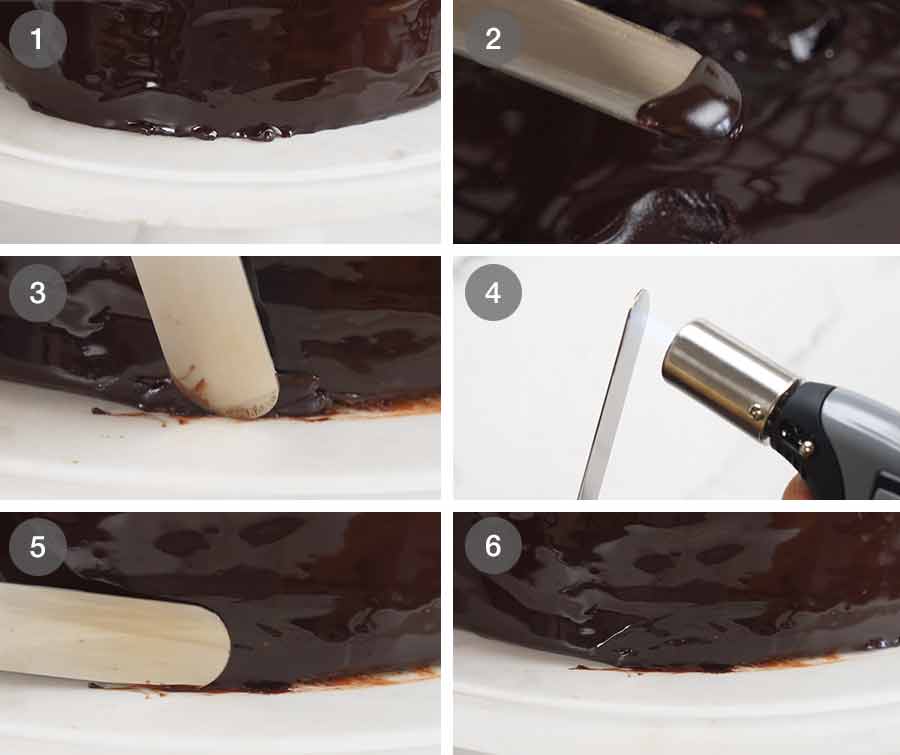
So here are some tips on how to rectify Mirror Coat blemishes:
-
Await until the glaze is set – Firstly, wait until the mirror glaze is fix before attempting repair work otherwise yous can make the blotch worse as the glaze is yet runny;
-
Use excess mirror coat left on the catching tray or leftover in the jug to patch up dents and crevices;
-
Smear it on / in the trouble areas;
-
Heat a palette knife or butter knife with a accident torch, gas lighter, or a gently over a low stove – simply briefly. Mirror Glaze melts super easily – you don't need it to be hot. If information technology sizzles on contact with the mirror coat, it's too hot!
-
Wipe across messy patched up surface area – don't be also tiresome and don't do it repeatedly otherwise y'all may cook the ganache underneath!
-
Voila! It's (practically) flawless!
-
Blow torching direct (or gas lighter) – mirror coat melts easily, and so just lightly waving the very tip of the blow torch flame over a blemish will smooth out whatever dents. It does go out a slight blemish so you won't take a pure flawless finish, but at least it is subtle and smoothen. Don't go too enthusiastic with the blow torch otherwise you lot volition melt off the mirror coat and/or the ganache underneath!
-
Decorations! Never hesitate to use a sprinkle of gilt dust or a strawberry or gilded leafage to strategically cover up blemishes!
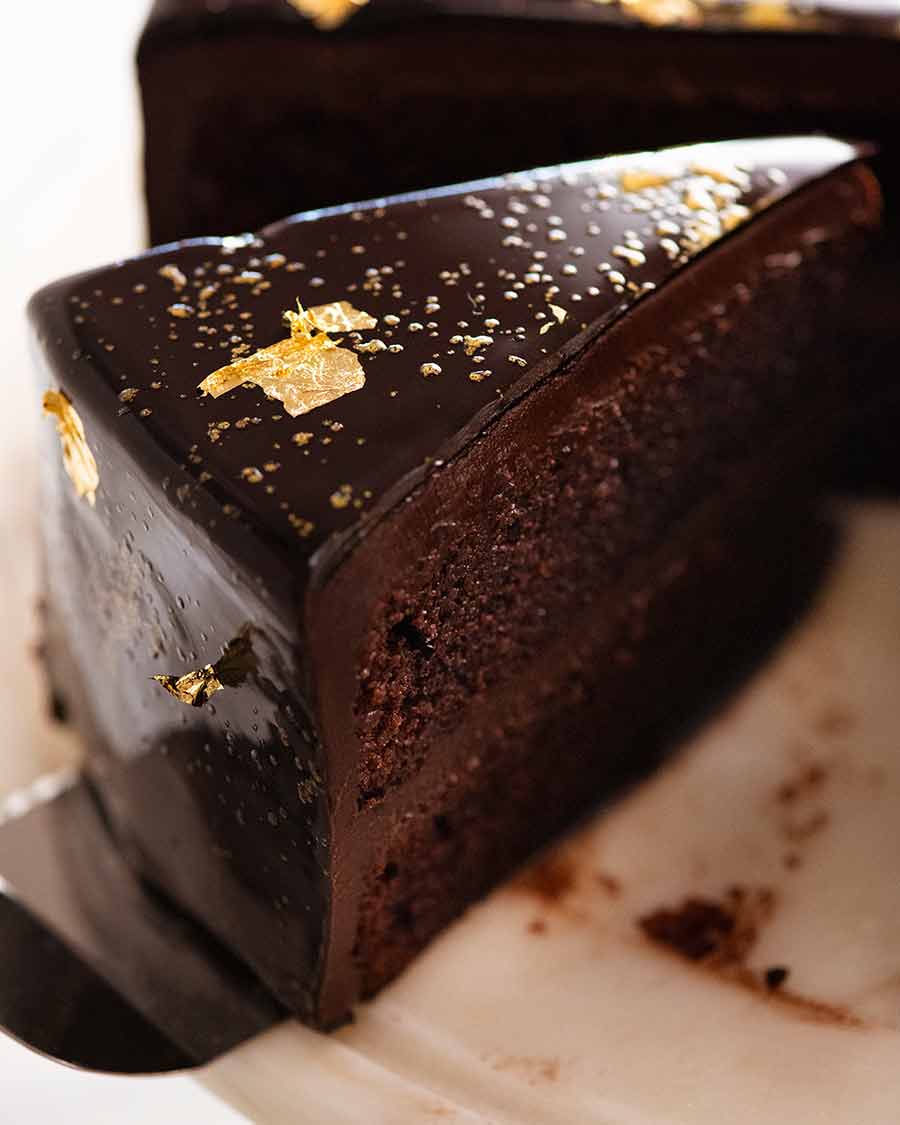
This is what I used to decorate my cake: Gold leaf and golden dust, purchased from Woolworths in Australia (it's our equivalent of Walmart in the US and Sainsbury's in the U.k.). And no, they're not there for the purpose of covering a million imperfections 😂
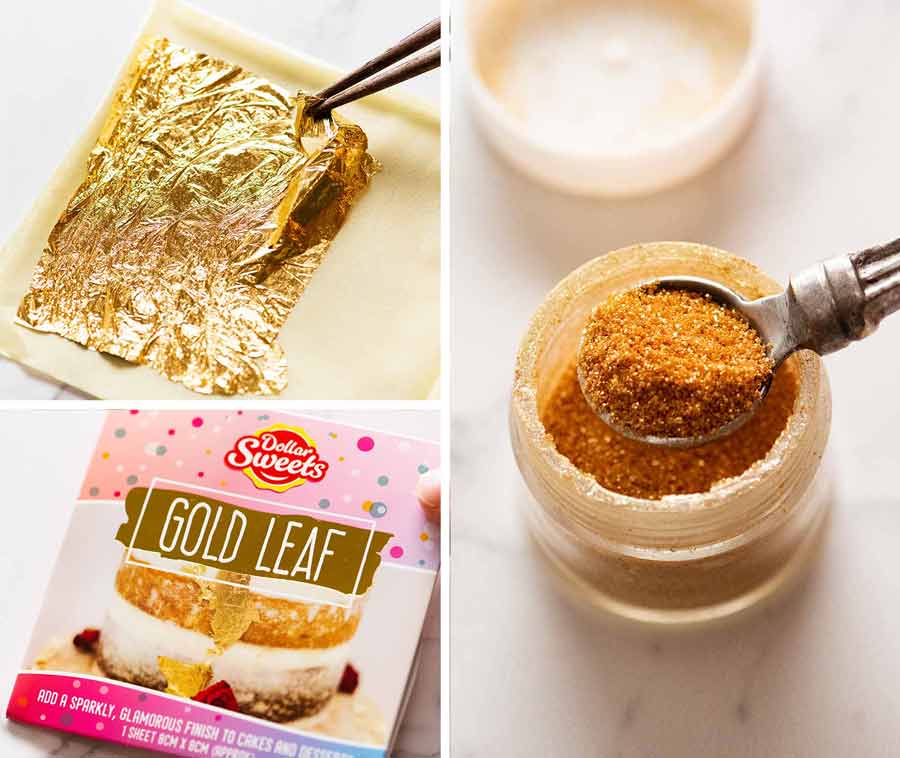
Freezing and refrigerating Mirror Coat
It's worth mentioning that the Mirror Glaze itself tin be made ahead and refrigerated for up to a week or even frozen. Information technology just needs to be reheating gently then stirred very gently until it is one time again smoothen and pourable, and so cooled to 30°C/86°F equally required by the recipe.
Reheated Mirror Glazes will go bubbling in them in the stirring process. Information technology'south inevitable, no thing how gently you stir them. But removing them is easy – just pass a blow torch or even a lighter lightly across the surface of the mirror glaze where the bubbles are, and lookout in wonder every bit the bubbles disappear!
Also, the final strain of the Mirror Coat into the pouring jug will strain out whatever nasty bubbling.
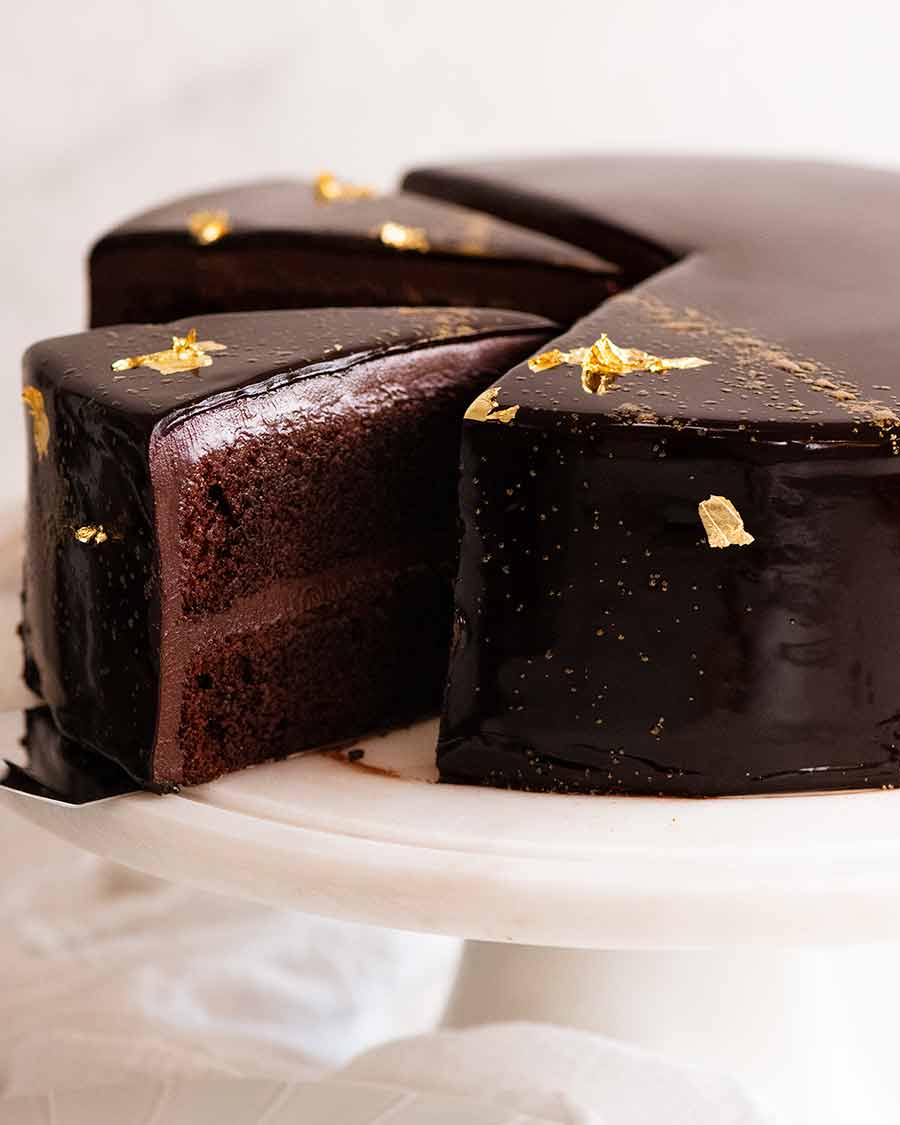
Storing Mirror Cakes
Once the Mirror Glaze has been practical, they seal the cake completely so they can be stored in the fridge and patisserie windows without having to cover them. Very highly-seasoned for practical purposes!
However, all too often, patisseries and block makers prioritise the shelf life benefits and make the mirror glaze as well thick and too rubbery. Hence the dazzler of homemade – so we tin make it properly!
Mirror Cakes don't even demand refrigeration every bit long every bit it's cool – the glaze melts in warm temperatures above around 25°C/ 77°C. Considering it's been really cool/common cold here lately in Sydney while I've been shooting/testing out this recipe ready for sharing, I've merely kept it under a block dome on the counter.
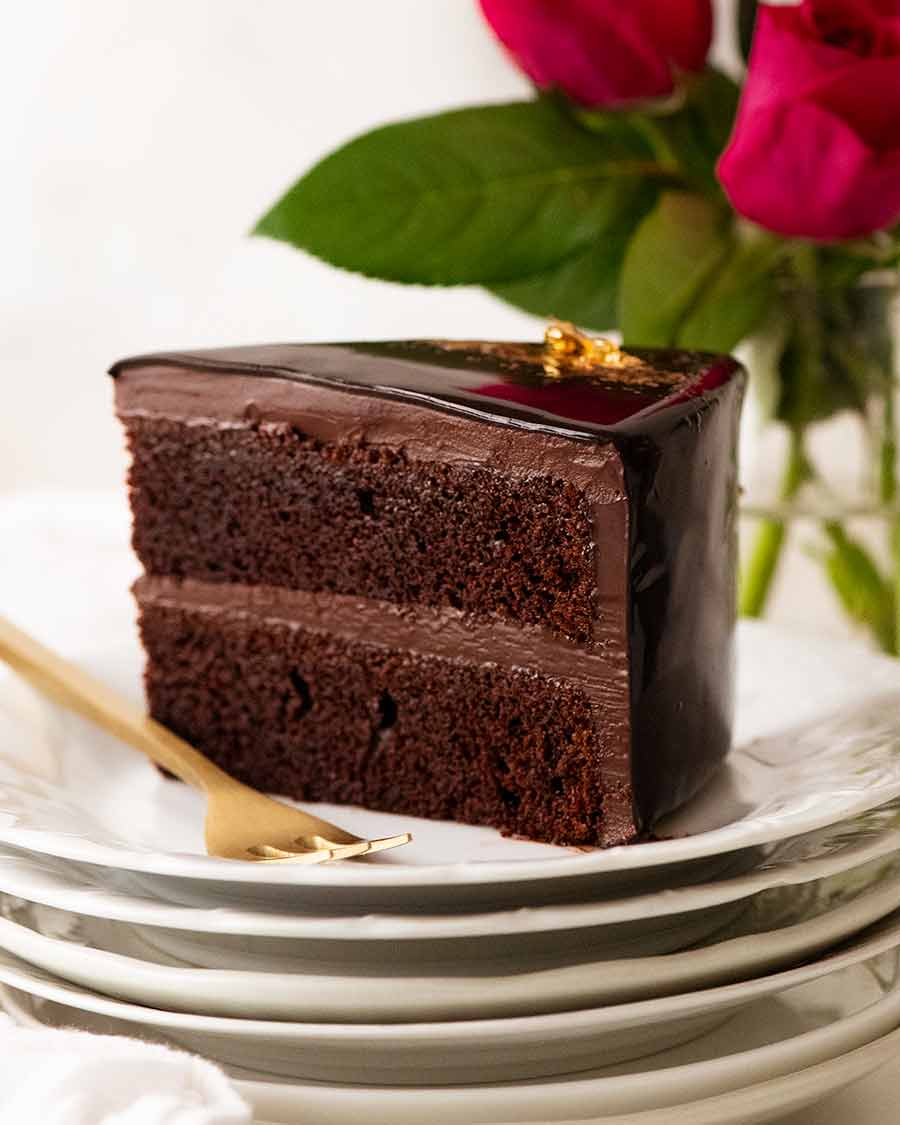
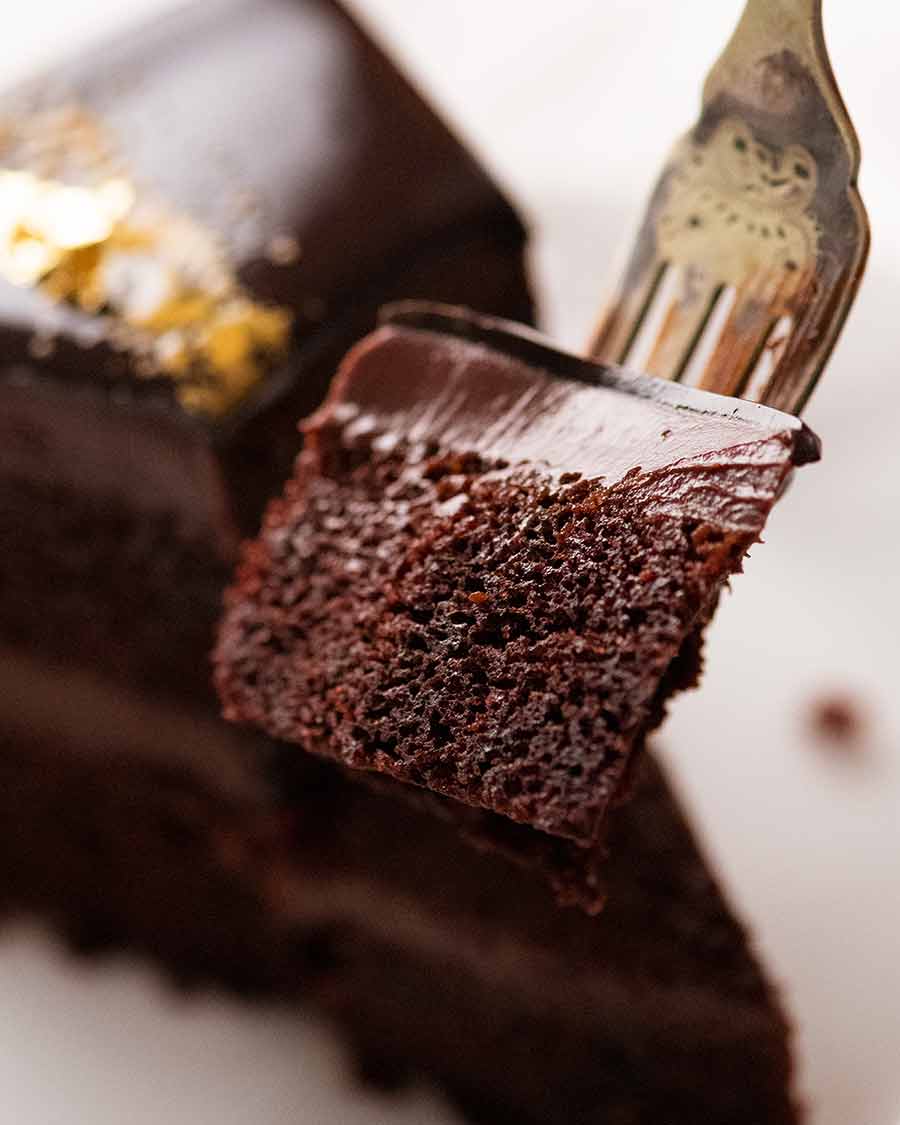
And in closing …
And with that – I have now shared with you lot everything I know about Mirror Glazes!!
I know that's an enormous amount of data, simply the actual execution of a Mirror Glaze is non that hard. It merely takes patience – lots of cooling / refrigeration steps.
For me personally, this has been the single nigh well received cake past friends and family in the half dozen years since I started this website. Not simply for how professional and impressive it looks, but also for the flavour and how it eats. It looks so sinfully rich and yet it is not – considering the Mirror Glaze is wafer thin, and the ganache layer is not that thick either.
And here'southward some final words of encouragement I have to offer: Then what if it'southward non perfect?? Even if yours is a bit bumpy, the glaze volition however be so shiny. Far more than shiny than you can achieve with any other glaze or frosting. And more importantly, it is nevertheless going to gustation 100% amazing ! – Nagi x
Lookout man how to make it
Subscribe to my newsletter and follow along on Facebook, Pinterest and Instagram for all of the latest updates.
Servings 12
Tap or hover to scale
Recipe video in a higher place. Deceptively straight forward, it mainly takes patience! The 3 cardinal things for a flawless, reflective mirror glaze are:
1. Smooth frosting and level cake – considering bumps and dents show upwards on shiny glazes. Meet my tutorial for How to Make Frosting Smooth on Cakes;
2. Ensure the glaze is completely shine (just follow my recipe); and
3. Ensure the glaze is at 30°C/86° and then it spreads smoothly for a thin, flawless finish. Proper Mirror Glazes are no thicker than 3mm and are not made with condensed milk, for superior results (read in mail for more info).
Inactive cooling time includes time to cool Chocolate Ganache though directions to make and spread are in separate recipes (come across Ganache recipe and Smooth Frosting postal service).
- ane x 20cm / 8" chocolate block (2 layers) (Notation 1)
- two batches Nighttime Chocolate Ganache (Note 2)
Gelatine for glaze:
- 2 one/2 tbsp water (just cold tap water)
- 4 tsp gelatine powder (Note three)
Mirror Coat:
- 2/iii cup water
- two/3 cup cream , pure / regular whipping cream, better than thickened/heavy cream (Note iv)
- 1 cup cocoa pulverisation , unsweetened, sifted (preferably dutch processed, Note 5)
- i loving cup + 2 tbsp white carbohydrate , pulley/superfine (Note half-dozen)
Decorating (optional, as pictured)
- Golden dust and gold foliage , optional decorations (Note seven)
Cake and Ganache Frosting preparation:
-
Air-condition cake layers for at least i hr until well-chilled (for easier handling). Then trim cake to make it level and frost cake with chocolate ganache and so it's smooth and level (follow the tutorial in this post: How to Frost Cakes Smoothly).
-
Later on the ganache is smooth and level, refrigerate for at least i hour before coating with Mirror Glaze.
Make Mirror Coat:
-
Flower gelatine: Place water in a modest basin. Then sprinkle gelatine across surface, mix just and then all the powder is wet. Get out for 5 minutes – it will become similar a rubber consistency. (This is chosen "blooming gelatine".)
-
Whisk cocoa and water: Place cocoa and h2o in a medium saucepan then mix until about lump-free. It will be like a paste.
-
Add cream and sugar: Add a splash of cream to cocoa mix and stir. It volition loosen up. Add remaining cream and sugar, and then GENTLY continue to mix to combine. Do not mix vigorously and do not use a whisk (Note 7).
-
Bring coat to boil: Turn stove onto medium high heat. Every bit soon every bit it comes to the eddy, remove from the stove.
-
Dissolve gelatine: Add gelatine lump, then GENTLY stir until it dissolves and yous have a smooth glossy coat. (There may be some white cream, that's ok.)
Absurd & Strain Mirror Coat:
-
Beginning straining: Using a shallow basin and small fine mesh strainer, strain the glaze into a basin. Pour and position the strainer so the glaze falls the smallest altitude possible. If you cascade from a summit, this creates bubbling = bad!
-
Bubble check: Twist the basin dorsum and forth between your easily quickly. This volition make any bubbles ascent and get together in the centre. If you see bubbles, see "Note 8: Bubble Troubleshooting".
-
Absurd glaze: Cover with cling wrap, pressing the cling wrap onto the surface of the glaze to preclude a skin from forming. Cool on the counter for 2 hours until it reaches thirty°C/86°F. Run across Note 9 for overnight refrigeration.
-
Second straining: Just before pouring over the block, strain the glaze into a jug. As before, tilt the jug and strainer as you pour the glaze in to minimise the altitude the glaze falls.
Glazing!
-
Transfer cake to rack: Remove block from fridge, transfer onto a rack. (Encounter Notation 9 for how I practise it.) Place rack on a tray to catch backlog glaze.
-
Cascade over mirror glaze: Starting at the eye of the block, cascade the glaze on, moving in an expanding spiral motility gradually towards the outer edge of the block, to brand the glaze spread across the surface and drape like drape down the sides. For the most perfect surface, try to do it in i motion without breaking the cascade. Pour with confidence in a thick stream rather than a thin drizzle (which might set too quick and leave drips).
-
Ensure all sides are fully coated – if not, quickly do a little pour downwardly the sides to coat the naked patches.
-
Transfer block to platter: Earlier the mirror glaze sets (takes ~10 minutes), motion the block to a block platter (Annotation 9 once more for my cake-shifting method).
-
Gear up blemishes – Use excess glaze on the tray and in the jug to fill gaps and tears. Then smooth over with a warmed palette knife (either lightly warm with a accident torch or dip into warm water and wipe). Come across video for demo.
How to Slice Block Cleanly with Neat Layers:
-
Fill a tall jug with warm tap water. Dip a knife in, then wipe dry. Make one slice into the block.
-
Clean knife, dip in warm water and dry out over again. Make your 2d cut to get your wedge. Pull wedge out and curiosity at the perfect layers before continuing to cut more than slices! See notes for storage.
ane. Chocolate cake – The Chocolate Cake recipe I recommend is an excellent cake for a Chocolate Mirror Glaze Cake. The texture is tender only not as well delicate for handling. It'south chocolatey, not too sweet, and looks and tastes sensational with the Ganache and Mirror Glaze. And chiefly for kickoff timers, the block is a 1-basin, easy recipe and it stays moist for days – then you can intermission the Mirror Coat up into stages over several days (if you want!)
ii. Chocolate Ganache – Y'all will need to make a double batch of the Dark Chocolate / semi-sweet chocolate ganache recipe in my Ganache recipe. You will finish up with leftovers, it'due south more near not having to recycle ganache mid-frosting which is messy.
Apply the recipe scaler on the Ganache recipe. Tap on servings figure and slide until the chocolate quantity becomes 500g/16 oz.
3. Gelatine pulverization – Just regular gelatine pulverisation sold in niggling containers at the grocery store.
four. Cream – Pure cream or what'south labelled "regular whipping cream" in the US is best and most archetype, simply it works but fine with thickened/heavy cream too (the glaze is a wee flake thicker, but it'south actually not a problem).
DO Non use: Light or low fat cream, cooking cream or long-life foam (ie. shelf-stable).
5. Cocoa pulverisation – Dutch processed has a more than intense chocolate flavour and color, only is slightly more expensive. I recommend it for the best, nearly luxurious results. Just the recipe works 100% perfectly with regular cocoa powder likewise.
6. Sugar – Caster/superfine sugar is all-time because the grains are smaller so you tin can be certain it will melt quickly. Regular / granulated white sugar is fine as well simply merely double-check to ensure information technology'south fully melted before adding the gelatine.
vii. Gilded dust and gold leaf – Both are constitute in the blistering aisle of Coles and Woolworths in Commonwealth of australia. Both totally edible!
8. Bubbling and lumps are the enemy of mirror glazes. And then from this step onwards, every direction is designed to ensure the coat stays perfectly glossy, smoothen, lump-free and bubble-free!
Bubble troubleshooting – Bubbling are an effect with Mirror Glazes considering the thick glaze means they don't burst past naturally. They form by over-stirring and they particularly occur when reheating solidified mirror glazes. You either take to prick them on the surface one by ane, OR lightly pass a blow torch beyond the surface which volition instantly make them burst.
ix. Moving cake (ie. frosted block onto rack, and then one time glazed, from rack to serving platter) – See in postal service for footstep photos and video for visual demo. Utilize two 10 large palette or kitchen knives. Slide them under the cake, elevator and transfer. And then use a butter knife to slide the palette knives out without disturbing the ganache or mirror glaze (video above is helpful to demonstrate this).
ten. Glaze refrigeration or freezing – Cover with cling wrap contacting the surface, absurd for 30 minutes on the counter. Then refrigerate overnight or freeze. If you freeze it, thaw first before reheating. And then reheat 30 seconds in the microwave on medium, gently stirring / breaking upward jelly lumps. Microwave another 20 seconds, stir again, then in xv 2nd increments until it is liquid again. Reheating mirror glaze Volition create bubbles, so run into Note viii for how to remove them. Be sure to too exercise the Bubble Check by twisting the bowl dorsum and forth chop-chop between your hands (described in Instructions).
11.Excess mirror coat on tray – Mirror Coat is essentially a chocolate jelly and so eating it with a spoon is non that pleasant (hence why it should be a THIN layer!). So you won't exist tempted to eat it off the tray once it sets. Even so, if the tray is super clean, y'all can strain it and reuse it – run across above for refrigerating or freezing. But the glaze needs to be make clean and blemish-free!
12. Mirror Glaze Cake Storage:
- The glazed cake can remain on the counter if the room temperature is 22°F/72°F or lower (mirror glaze melts when as well warm). Otherwise, refrigerate – you don't demand to cover an uncut cake because the mirror glaze seals information technology!
- Using the Chocolate Cake, this Mirror Coat Chocolate Block is perfect for four days, and still excellent on Solar day 6 (the cake is really moist).
- The Mirror Coat will remain shiny and sparkly for days – dissimilar ones made with condensed milk which lose their shine after a twenty-four hours or and then.
Let them eat cake! eight more classic cakes
Life of Dozer
No chocolate for y'all Dozer. And none of my Beef Pho either!!
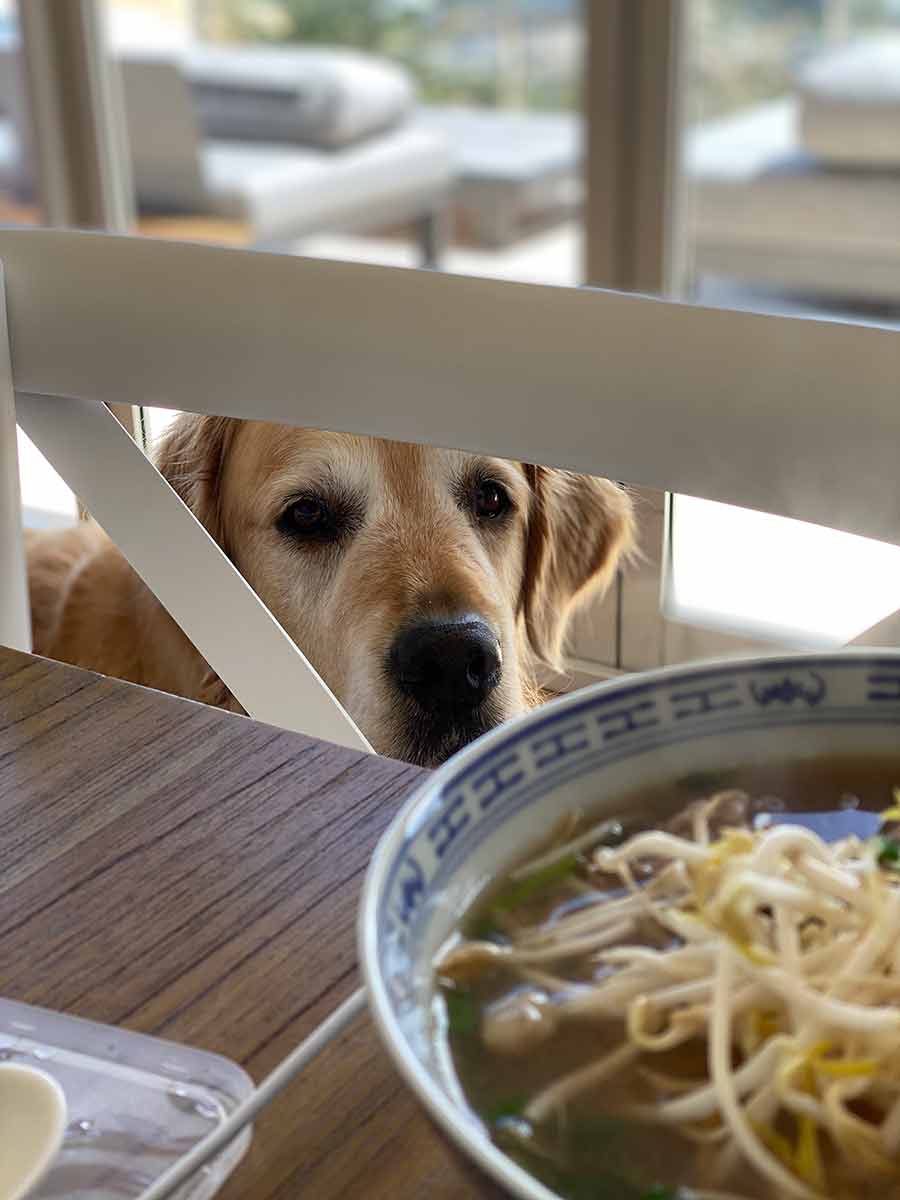
OK fine, y'all tin have One noodle!
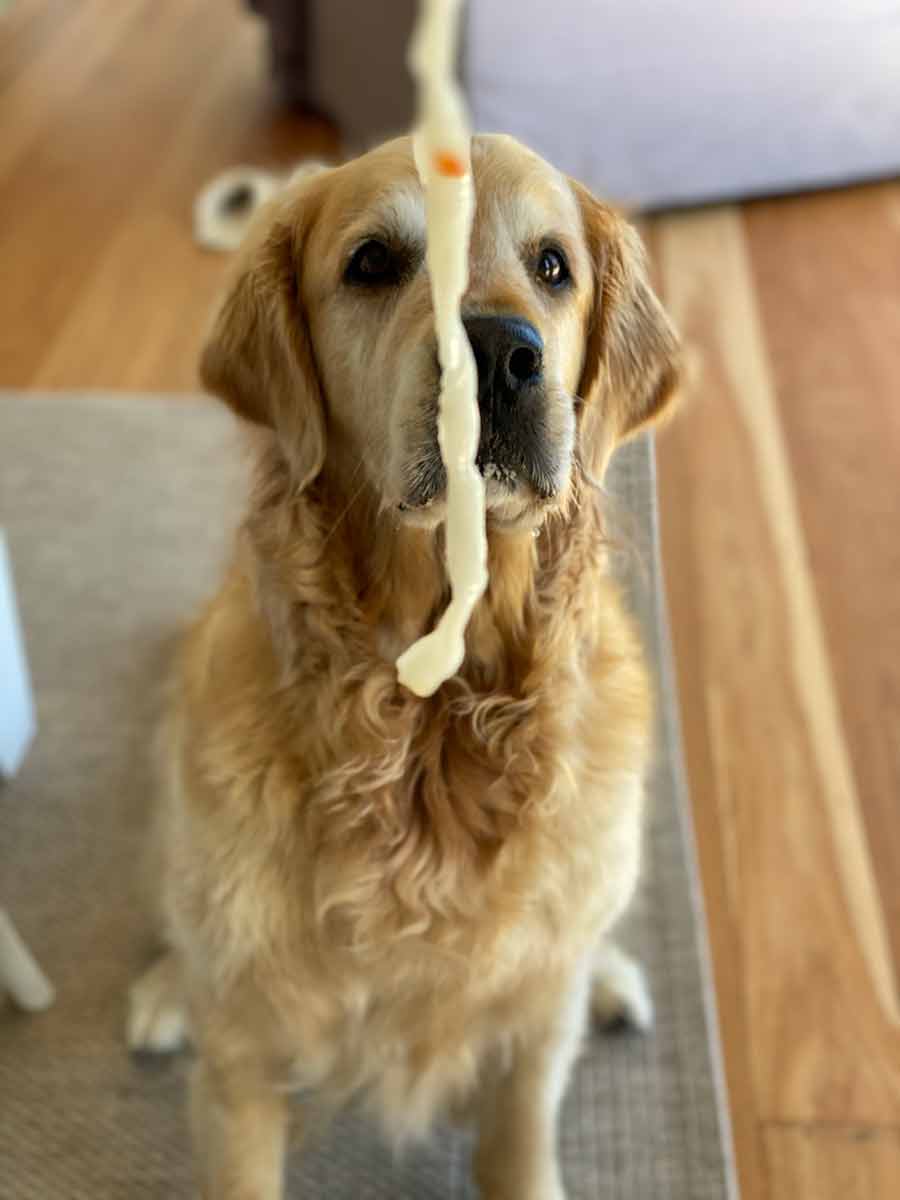
How To Make A Cake Glaze,
Source: https://www.recipetineats.com/chocolate-mirror-glaze/
Posted by: florioclan1973.blogspot.com


0 Response to "How To Make A Cake Glaze"
Post a Comment